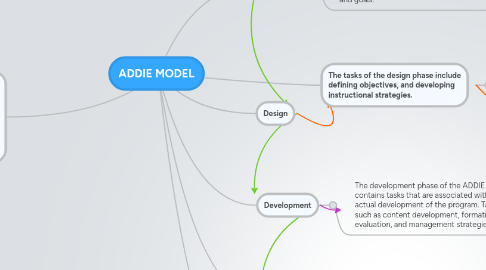ADDIE MODEL
by Chris Villani


1. Reference: Cennamo, K. & Kalk, D. (2005). Real world instructional design. Florence, KY: Thomas Wadsworth Publishers. ISBN: 0534642675
2. The tasks of the design phase include defining objectives, and developing instructional strategies.
2.1. The deliverables associated with the design phase include: objectives, tests, and design specifications (Cennamo, Kalk, 2005).
3. Design
4. Development
4.1. The development phase of the ADDIE model contains tasks that are associated with the actual development of the program. Tasks such as content development, formative evaluation, and management strategies.
4.1.1. The deliverables at the development stage include the development of a storyboard, script (if necessary), and the instructional materials (Cennamo, Kalk, 2005).
5. Analysis
5.1. Within the analysis stage tasks include developing a needs assessment, identifying learner characteristics, and identifying context and goals.
5.1.1. The deliverables at the analysis stage include behavioral tasks and the entry skills of the learner (Cennamo, Kalk, 2005).
6. Implementation
6.1. The tasks associated with the implementation stage include the planning and management of instructional delivery.
6.1.1. The deliverables at this stage of the model include support materials and any other references to further learning (Cennamo, Kalk, 2005).
7. Evaluation
7.1. The evaluations phase includes the results of formative evaluations that have taken place during the development of the project, and also the results of the final summative evaluaiton.
7.1.1. The deliverables at the final stage of the model are derived from the results of the evaluations and include recommendations and a project/closure report.
